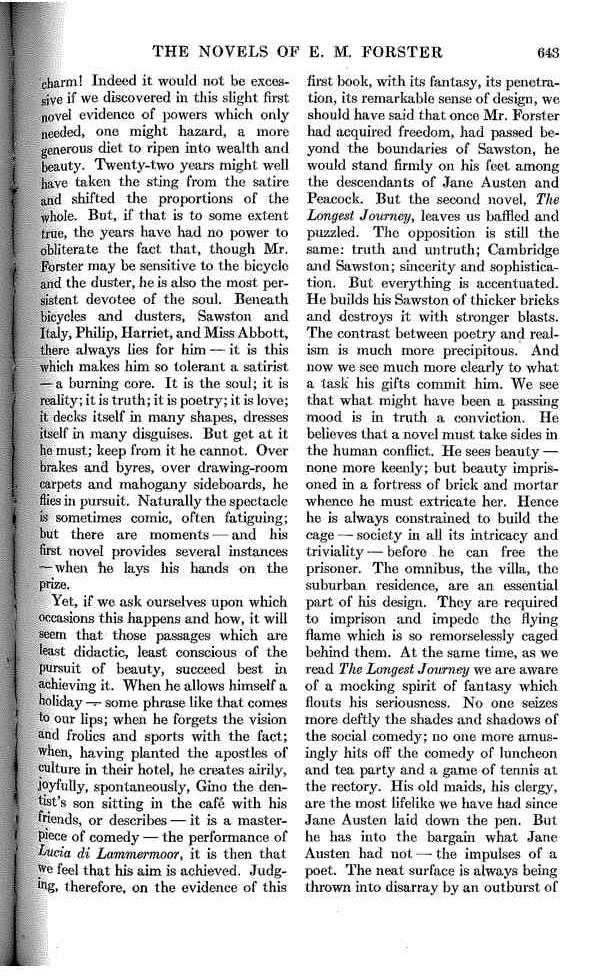
charm! Indeed it would not be exces-
sive if we discovered in this slight first
novel evidence of powers which only
needed, one might hazard, a more
generous diet to ripen into wealth and
beauty. Twenty-two years might well
have taken the sting from the satire
and shifted the proportions of the
whole. But, if that is to some extent
true, the years have had no power to
obliterate the fact that, though Mr.
Forster may be sensitive to the bicycle
and the duster, he is also the most per-
sistent devotee of the soul. Beneath
bicycles and dusters, Sawston and
Italy, Philip, Harriet, and Miss Abbott,
there always lies for him—it is this
which makes him so tolerant a satirist
—a burning core. It is the soul; it is
reality; it is truth; it is poetry; it is love;
it decks itself in many shapes, dresses
itself in many disguises. But get at it
he must; keep from it he cannot. Over
brakes and byres, over drawing-room
carpets and mahogany sideboards, he
flies in pursuit. Naturally the spectacle
is sometimes comic, often fatiguing;
but there are moments—and his
first novel provides several instances
—when he lays his hands on the
prize.
Yet, if we ask ourselves upon which
occasions this happens and how, it will
seem that those passages which are
least didactic, least conscious of the
pursuit of beauty, succeed best in
achieving it. When he allows himself a
holiday—some phrase like that comes
to our lips; when he forgets the vision
and frolics and sports with the fact;
when, having planted the apostles of
culture in their hotel, he creates airily,
joyfully, spontaneously, Gino the den-
tist's son sitting in the café with his
friends, or describes—it is a master-
piece of comedy—the performance of
Lucia di Lammermoor, it is then that
we feel that his aim is achieved. Judg-
ing, therefore, on the evidence of this
[new column]
first book, with its fantasy, its penetra-
tion, its remarkable sense of design, we
should have said that once Mr. Forster
had acquired freedom, had passed be-
yond the boundaries of Sawston, he
would stand firmly on his feet among
the descendants of Jane Austen and
Peacock. But the second novel, The
Longest Journey, leaves us baffled and
puzzled. The opposition is still the
same: truth and untruth; Cambridge
and Sawston; sincerity and sophistica-
tion. But everything is accentuated.
He builds his Sawston of thicker bricks
and destroys it with stronger blasts.
The contrast between poetry and real-
ism is much more precipitous. And
now we see much more clearly to what
a task his gifts commit him. We see
that what might have been a passing
mood is in truth a conviction. He
believes that a novel must take sides in
the human conflict. He sees beauty—
none more keenly; but beauty impris-
oned in a fortress of brick and mortar
whence he must extricate her. Hence
he is always constrained to build the
cage—society in all its intricacy and
triviality—before he can free the
prisoner. The omnibus, the villa, the
suburban residence, are an essential
part of his design. They are required
to imprison and impede the flying
flame which is so remorselessly caged
behind them. At the same time, as we
read The Longest Journey we are aware
of a mocking spirit of fantasy which
flouts his seriousness. No one seizes
more deftly the shades and shadows of
the social comedy; no one more amus-
ingly hits off the comedy of luncheon
and tea party and a game of tennis at
the rectory. His old maids, his clergy,
are the most lifelike we have had since
Jane Austen laid down the pen. But
he has into the bargain what Jane
Austen had not—the impulses of a
poet. The neat surface is always being
thrown into disarray by an outburst of






